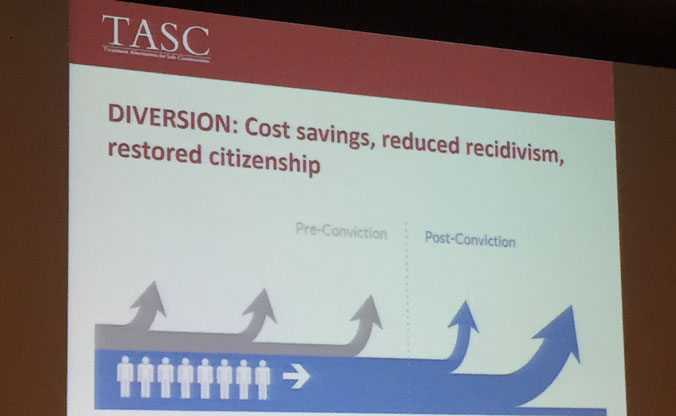(Chicago) – Several criminal justice diversion programs in Illinois were showcased at the recent annual conference of National TASC, an association of programs that connect justice systems to community-based treatment.
TASC, Inc. of Illinois served as the host organization for the national conference, which took place in Chicago and drew attendees representing programs in states from North Carolina to Hawaii. One of the conference themes was the importance of diverting people with non-violent charges away from traditional criminal justice processing and into services in the community.
Although diversion is not a new concept, public opinion, health coverage brought about by Medicaid expansion, and bipartisan efforts toward criminal justice reform have propelled such initiatives to the forefront of public policy. The goals of such programs vary depending on the jurisdiction, but most aim to reduce the numbers of people going into the justice system, reduce jail stays, strengthen connections to health and supportive services in the community, and reduce recidivism.
Illinois Diversion Programs Highlighted
At the conference, held April 25-27 at the Westin Michigan Avenue, experts who have implemented front-end diversion programs in Illinois offered their experiences and strategies for developing these initiatives. Chief Eric Guenther, public safety director for the Village of Mundelein, and Lake County State’s Attorney Michael Nerheim described their collaboration in implementing smart-on-crime approaches. Motivated by the dramatic increase in opioid overdoses and deaths in the area, they are leading the development of a collaborative effort to divert people with drug problems to community-based treatment rather than arrest them. Similar programs are being designed and implemented across Illinois and the country, inspired by the Gloucester, Massachusetts, Angel Program launched in 2015.
“We have been losing a lot of young people to overdose deaths all over our county. We had to come up with a new way of dealing with this [opioid] epidemic,” said Nerheim. “The vast majority of people who come into the system are going to be back with us—back in society—and we want them to be productive members. Everyone should have the opportunity for a second chance.”
Chief Guenther noted the importance of building trust between the community and law enforcement, so that community members feel comfortable coming to the police department for help. He remarked on the police department’s unique ability to engage people any time of day, any day in the year. “A person may decide at 2:00 a.m. that they want out [of addiction], and having to wait until 8:00 a.m. may mean that we lose that window.” Guenther also stressed that planning processes should include people in recovery to ensure that programming and messaging will appeal to individuals who need help.
Mark Kammerer, the alternative prosecution/sentencing unit coordinator at the Cook County, Illinois, State’s Attorney’s Office, described the array of programs in place to divert people out of traditional case processing, noting that his office has been operating diversion programming in some fashion since the 1970s. “We now have interventions for people with the least extensive criminal background to high-risk, high-need individuals. One size does not fit all, so we offer a continuum of interventions. The goal is to identify and screen people to get them into diversion programs sooner, rather than later, in the criminal justice system.”
TASC Vice President George Williams, who offered the conference’s opening remarks, spoke of TASC’s 40-year history in advocating for people who need help, and emphasized that clients, constituents, friends, and family members are at the heart of this work. “Everything we do in this room is for the rights, interests, health, and needs of the men and women who have come through our doors,” he said.
New Opportunities via Medicaid Expansion
“Diversion programs are surging in popularity and evolving in response to current needs,” said Laura Brookes, policy director at TASC. Introducing the panel discussion, Brookes offered that the justice system can divert many people who represent a low public safety risk to programs in the community, stemming the tide of people coming into the system at the front end and throughout it.
“Now is a particularly exciting time to be involved in this work, not only because of the broad support for much-needed reform, but also with the expansion of Medicaid in many states under the Affordable Care Act,” said Brookes. “This means that local and state governments can save justice and corrections costs by establishing connections to Medicaid-reimbursable behavioral health and medical resources in the community. These resources can help increase diversion, as justice systems become confident that many of people they are diverting will be able to access the care they need and reduce offending.”

Benefits of diversion programs were highlighted at the 2016 National TASC conference in Chicago.